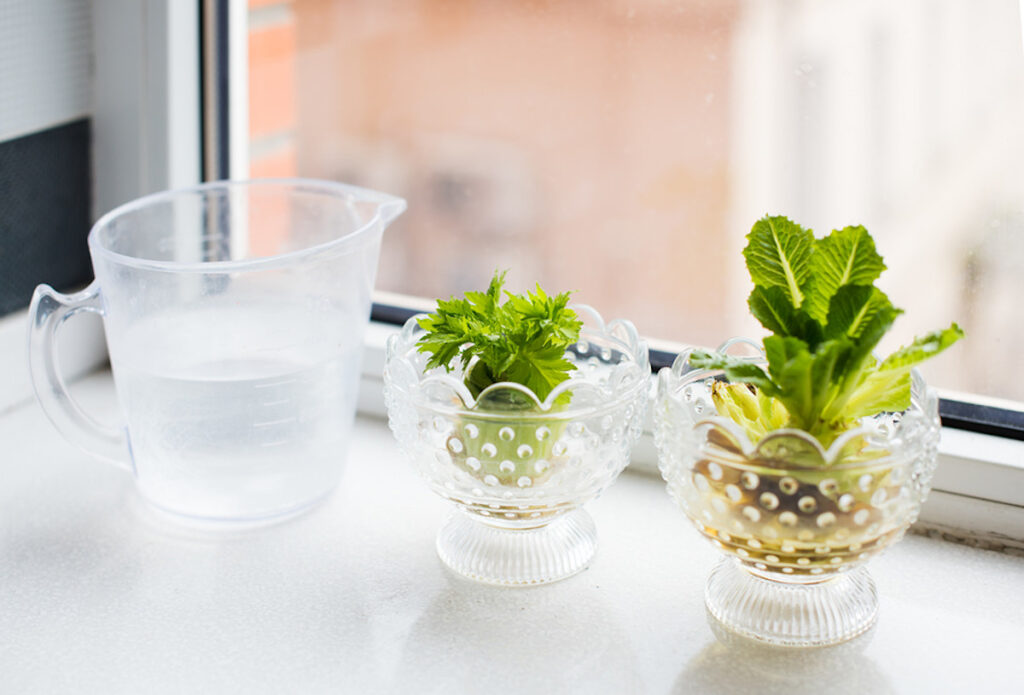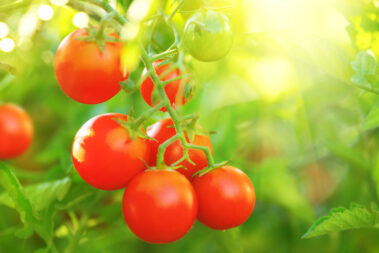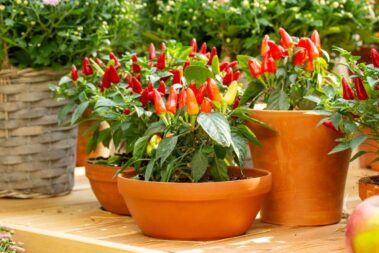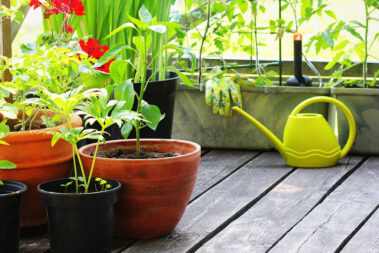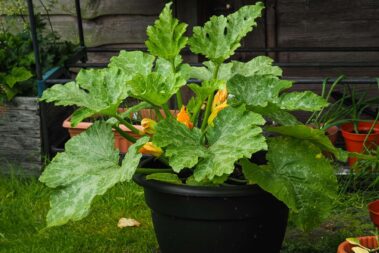If it weren’t for the constant need for fresh produce, I would be happy to only go to the store about once a month. Unfortunately, as you are probably all too aware, keeping grocery store veggies fresher longer than a week or two, is close to impossible.
But there still may be a way to avoid those constant supermarket trips.
As it turns out, a great number of produce items can be regrown over and over from just a small scrap or cutting of the original piece you bought at the grocery store.
Here are all of the easiest veggies to regrow from cuttings and scraps that require almost no effort on your part.
Table of Contents
Onions, Garlic, and Scallions
Green onions are by far one of the easiest veggies to regrow from scraps, but other members of the allium family, including garlic, onions, and leeks aren’t much harder to repropagate.
How to Grow Green Onions and Other Alliums from Scraps
- Save the root end of the bulb or stalk (at least ½ an inch for bulbs)
- Place it root down in a shallow dish of water
- Place the dish in a sunny window and change the water frequently
- Roots will start growing in a few days and the head of the plant will follow
- For green onions/scallions continue to grow in water until ready for harvest; For bulb onions and garlic, once roots form, transplant and cover with a thin layer of soil.
Carrot and Other Root Veggie Greens
As great as it would be to be able to regrow your favorite root snacks from kitchen scraps, that just doesn’t happen with these veggies. But you can use the tops of your favorite roots to regrow those nutritious and versatile greens.
How to Grow Root Vegetable Greens from Scraps
- Save the top of the root (about 1 inch)
- Place this root side down in a shallow dish of water
- Place the dish in a sunny window and change the water frequently
- Greens should start to grow quickly
- Harvest as needed
Celery
Celery is another produce department staple that you can easily regrow over and over in your own home. For this one, it is best to transplant it into your garden or a pot of dirt once the roots and leaves begin to take off.
How to Grow Celery Using Kitchen Scraps
- Save the base of your celery clump (about an inch)
- Place it in a shallow dish of water
- Place the dish in the sun and change out the water frequently
- Once roots and leaves begin to develop, transplant it into soil
- Once the stalks reach the desired thickness, harvest and start again
Leafy Greens
Romaine lettuce and other large bunch greens like bok choy can easily be regrown in water and then transplanted into the garden or pots of dirt. For these, make sure you keep the thick stump end intact when cutting up the leaves for salads and other dishes.
How to Grow Lettuce from Scraps
- Save the thick stump end
- Place this leaf end up in a shallow dish of water
- Place the dish on a window sill and change the water frequently
- After new leaves have had a few days to regrow, transfer the plant to the garden
- Once a new bunch of greens has formed, harvest and start again
Helpful tip: if you want fresh lettuce and leafy greens to last longer, try storing them in jars.
Cabbage
Like bunch lettuce, cabbage can easily be enticed to regrow from just the thick base of the head. This plant will also need to be transplanted into the garden once it begins to grow new leaves.
How to Grow Cabbage from Scraps
- Save the stump end of the head
- Place this in a large, shallow dish of water
- Place the dish in a sunny location and change the water frequently
- Allow new leaves a few days to grow before transplanting into soil
- Harvest once the new head has reached the desired size
Sweet Potatoes and Yams
Ever grab your new bag of sweet potatoes only to find a few have already gone a little soft or started to grow eyes? Don’t toss them out! Instead, use those inedible potatoes to grow more you can eat.
How to Grow Sweet Potatoes Using Kitchen Scraps
- Save an overripe potato or about half of a potato you’re using for cooking
- Stick three toothpicks in a circle about 2/3rds the way up your potato
- Place the potato in a jar with the toothpicks resting on the rim of the glass (if using a half potato, set the cut end up)
- Fill the jar with water so the potato is about half submerged
- Allow the roots to grow until they are four inches in length and then transplant into the garden
Russet and Other Types of Potatoes
White potatoes can be grown in much the same way as sweet potatoes above, but there is actually a much easier way. This shouldn’t come as a surprise considering that these starchy veggies will happily try to grow in your cupboard if you let them.
How to Grow Potatoes from Scraps
- Save a few chunky skin scraps with eyes
- Plant these eyes face up in the garden
- You will see sprouts in a couple of weeks
- Harvest at the end of the season
Basil, Cilantro, Parsley, and Mint
Many stemmy herbs—such as basil, cilantro, parsley, and mint—can be easily regrown with the help of a glass of water. Once the new roots begin to develop, you can then transplant the herb into a pot, your garden bed, or your very own kitchen herb garden.
How to Grow Herbs from Cuttings
- Save the bottom portion of the stem (about 3 inches)
- Stand the stem up inside a jar
- Fill the jar so the stem is about half-submerged in water
- Once the new roots begin to grow, transfer the plant to soil
Save Money, Time, and Reduce Waste!
Regrowing your own produce from kitchen scraps can take a little practice.
The most common issue people will run into is having the scrap rot instead of regrow. You can usually avoid this outcome by changing out the water more frequently and making sure that additional green leafy parts and dead pieces are removed before placing the cutting in water.
For those plants that need to be moved to soil to fully mature, making that move sooner rather than later can also help avoid premature rot.
It may take a little time, but once you get the hang of regrowing vegetables from scrap, you will wonder why you ever threw so much money and time away at the supermarket in the first place.
- How to Pick the Perfect Watermelon For a Sweet Summer Treat - April 10, 2024
- Future Kind’s Foundations: A Multivitamin Made for Vegans - December 5, 2023
- Does Nutritional Yeast Go Bad? - November 28, 2023

